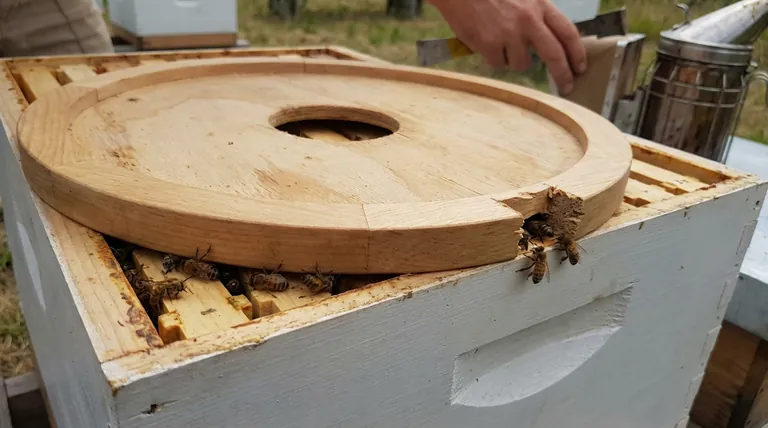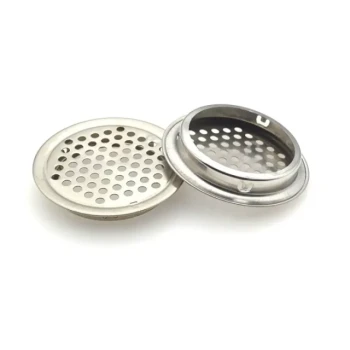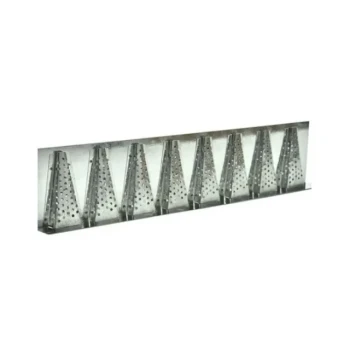At its core, an inner cover without a notch creates a trap for your bees. When bees move into the space between the inner cover and the telescoping outer lid, the absence of a notched exit means they can easily become trapped and crushed when you close the hive or as they try to find their way back down.
The notch on an inner cover is not an optional feature; it is a critical design element for bee safety and hive function. Its absence leads to unnecessary bee deaths and can hinder proper hive ventilation and management.

The Functional Role of the Inner Cover Notch
To understand the consequences of a missing notch, you must first understand its purpose. It serves two primary functions: providing an exit path and creating an optional upper entrance.
An Escape Route for Wandering Bees
Bees will naturally explore any available space within the hive, including the small gap between the inner cover and the outer lid.
A notch provides a clear, designated exit. This allows any bees in that top space to easily move back down into the frames or exit the hive entirely without getting lost or stuck.
Preventing Bee Entrapment and Death
The most direct consequence of a missing notch is bee mortality. When you place the heavy outer cover back on the hive, any bees on the top rim of the inner cover are at high risk of being crushed.
While bees might be able to escape through the central hole in the inner cover, this is not a reliable or intuitive path for them. Many will fail to find it and will perish.
Common Issues Caused by a Missing Notch
The problem goes beyond just a few lost bees. It points to a fundamental issue with equipment use that can impact the colony.
Increased and Unnecessary Stress
A well-designed hive minimizes stress on the colony. Trapping and killing bees, even in small numbers, introduces a constant, low-level stressor every time the hive is opened and closed.
Hindrance to Hive Management
The notch also serves as a functional upper entrance. By turning the inner cover so the notch is open to the outside, you provide another entry and exit point for foragers, which can reduce congestion at the main entrance.
In colder climates, this upper entrance is also crucial for ventilation, allowing moist air to escape and preventing condensation from dripping down on the cluster. A solid inner cover eliminates this management option.
How to Address a Missing Notch
Fortunately, this is one of the simplest problems to solve in beekeeping. If your inner cover lacks a notch, you should create one.
The Simple DIY Fix
You do not need to buy a new inner cover. Simply use a saw or a hive tool to cut or pry out a small section of the wooden rim.
A notch approximately one-half inch deep and one to two inches wide is sufficient to allow bees to pass through easily. This modification takes only a minute and permanently solves the problem.
Proper Orientation is Key
Once you have a notch, its orientation matters. Placing the inner cover with the notch facing up creates a dead-air space that provides insulation.
Placing the inner cover with the notch facing down gives bees about a 1/4-inch of space to move freely between the inner and outer covers without being crushed.
Making the Right Choice for Your Hive
A proper inner cover is a small but significant part of responsible hive management. Your decision on how to handle it directly impacts bee well-being.
- If your primary focus is bee safety: Immediately modify any inner covers that lack a notch to prevent bees from being trapped and killed.
- If your primary focus is effective hive management: Utilize the notch as an optional upper entrance to reduce congestion and improve winter ventilation.
Ultimately, ensuring your equipment serves the needs of your bees is a fundamental principle of successful beekeeping.
Summary Table:
| Issue Without a Notch | Consequence | Solution |
|---|---|---|
| Bee Entrapment | Bees get trapped and crushed between covers. | Create a Notch: Cut a 1/2" deep x 2" wide notch in the rim. |
| Poor Ventilation | Increased moisture and condensation in winter. | Use as Upper Entrance: Orient the notch to allow air flow. |
| Hive Management Issues | Lack of an optional upper entrance for foragers. | Proper Orientation: Notch down for bee space; notch up for insulation. |
Ensure your hive is equipped for success with HONESTBEE.
A missing notch is a simple problem with serious consequences for your colony's health and your management efficiency. At HONESTBEE, we supply durable, correctly designed beekeeping supplies and equipment to commercial apiaries and distributors through our wholesale-focused operations.
Let us provide you with the reliable equipment your operation depends on. Contact us today to discuss your needs and see how we can support your beekeeping success.
Contact HONESTBEE for Wholesale Supplies
Visual Guide

Related Products
- Inner Beehive Cover for Beekeeping Bee Hive Inner Cover
- Professional Insulated Winter Hive Wrap for Beekeeping
- Stainless Steel Round Beehive Air Vents for Ventilation
- Professional Galvanized Hive Strap with Secure Locking Buckle for Beekeeping
- Professional Insulated Plastic Bee Hives
People Also Ask
- How is the inner cover used to promote ventilation? Master Hive Climate Control for Healthy Bees
- What is the role of inner covers in insulated beehives? Master Moisture Control for a Healthy Colony
- What is an inner cover in a beehive and what are its features? A Key Tool for Hive Health & Management
- What is the recommended orientation for the rim of an inner cover? Master Hive Ventilation and Insulation
- What is the role of the inner cover in a beehive? Essential Climate Control for Hive Health



















